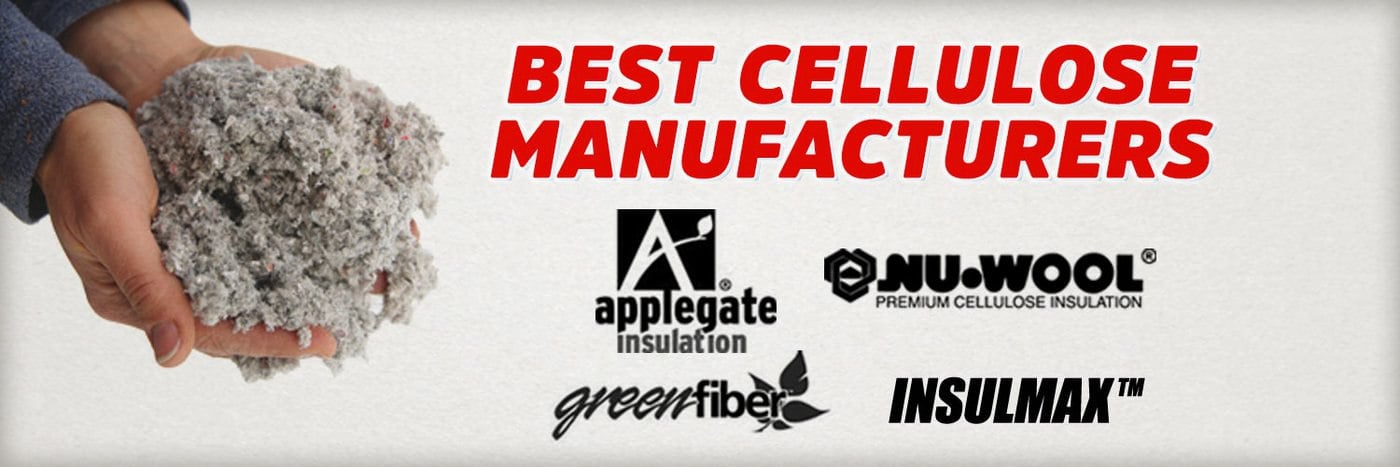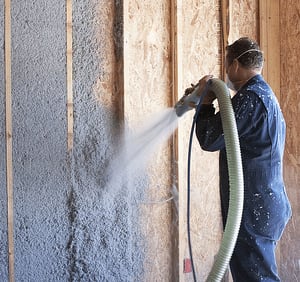Who Are the Best Cellulose Insulation Manufacturers?


You know your home needs new or updated insulation, and you are considering cellulose, but you want to make sure you are getting the best material.
The best manufacturers of cellulose insulation include GreenFiber, Insulmax, Applegate, and Nu-Wool.
RetroFoam of Michigan has more than 20 years of experience specializing in injection and spray foam insulations. While we specialize in foam, we have dealt with cellulose in homes that needed new or updated insulation.
Every now and again, we have customers that are looking for a cheaper insulation alternative and who want to know who manufactures cellulose insulation.
As we continue our efforts to provide homeowners with the best information available, we have compiled a list of the best cellulose insulation manufacturers.
Best Cellulose Insulation Manufacturers
 Cellulose insulation is the oldest form of home insulation available on the market.
Cellulose insulation is the oldest form of home insulation available on the market.
It can be found as either a loose-fill or blown-in insulation and can be used in both existing and new homes.
It is primarily made from recycled newsprint because the small particles form an insulation material that fits most spaces without disturbing the structure or finish.
Now let's dive into the top cellulose insulation manufacturers.
GreenFiber Cellulose Insulation
GreenFiber was established in 2000 and has grown to be the largest manufacturer of cellulose fiber insulation in the U.S.
The company's insulation is made with 85 percent recycled paper fiber and helps to reduce the energy used to heat and cool a home.
Here is a look at some GreenFiber products.
- 541 Blow-In Low Dust Insulation fills gaps and crevices and is made of 85 percent recycled fire resistant treated cellulose fiber insulation. It creates a thermal blanket that helps to prevent air leaks. It is best suited for attics and sidewalls DIY projects. The R-Value varies from R-13 to R-49 depending, on the thickness installed.
- 515 Blow-In Low Dust Insulation is less dense, so it is ideal for insulating attics, walls, and ceilings. It adds thermal, sound, and fire resistance. The material is made of 85 percent recycled paper fibers and is Class One Fire Rated. The R-Value varies between R-13 and R-44 depending on the thickness of cellulose installed.
- 500 Stabilized Attic Insulation is a blended cellulose insulation made for spray applications. It is made of 85 percent recycled paper fibers and is Class One Fire Rated. The R-Value varies between R-13 and R-49 depending on the thickness of the material applied.
- 735 All Borate Stabilized Wall Spray Insulation is made for spray wall applications, but can also be used in its loose form in attics, floors, and any dense pack applications. The insulation is made of 85 percent recycled paper, is treated to perform in extreme weather, and has a Class One fire rating. The R-Value varies between R-13 and R-38 depending on the thickness applied.
- 745 All Borate Stabilized Attic Insulation that is made specifically for spray applications in attics. It is made with 85 percent recycled materials and has sound, thermal, and fire features and benefits. The material’s R-Value varies depending on the thickness applied between R-13 and R-49.
- 765LD All Borate Loose Fill Attic and Wall Insulation is made for new construction or retrofitting loose-fill attic and wall applications. The material is made of 85 percent recycled paper fibers that are treated for fire resistance. The R-Value varies between R-13 and R-49 depending on the thickness of the insulation installed.
- Cel-Pak Premium All Borate Retrofit Insulation 773 Low Dust has a highly effective fire resistance and is Class A Fire Rated. The material reduces sound and air that can pass through gaps in the home. The loose fill formula consists of 85 percent recycled materials and works best insulating the space between floors, sidewalls, and open attic spaces. The material offers a low moisture sprayed or dense packed cellulose that must be installed by a professional. The R-Value varies between R-13 and R-49 depending on the thickness of cellulose applied.
If you plan to tackle your cellulose installation as a do-it-yourself project, GreenFiber has a section on the company's website that walks you through the process. From figuring out the R-Value you need to reach to listing everything you'll need to the process itself, GreenFiber has you covered.
Homeowners who have used the material have said they chose it based on the product's makeup of recycled paper materials. Another common theme reading through customer reviews is that the material doesn't produce too much dust, which is usually the case with other cellulose materials.
GreenFiber can be purchased directly from the manufacturer or at any home improvement store.
Insulmax Cellulose Insulation
Insulmax offers a blown-in cellulose insulation that works well to add to existing insulation in the attic to fill gaps or in sidewalls.
The material must be installed using a blowing machine.
Here is a look at Insulmax Blow-In Cellulose Insulation.
- Environmentally friendly insulation made of 85 percent recycled paper fiber that is treated for flame resistance giving it a Class One Fire Rating.
- Insulmax reduces noise while creating a thermal blanket making the home more energy-efficient.
- The R-Value varies between R-13 to R-60.
This blown-in cellulose can be done as a DIY project, but you'll need to rent a blower to be able to install it.
Insulmax is found at Menards, according to this Menards tech sheet on the product.
Applegate Cellulose Insulation
 Applegate cellulose insulation creates savings on monthly energy bills while reducing air infiltration.
Applegate cellulose insulation creates savings on monthly energy bills while reducing air infiltration.
Applegate was established in 1952 as a heating and cooling equipment contractor. By the 1970s, Applegate was providing cellulose insulation to contractors and continued to branch out from there.
The company offers blown-in cellulose, loose-fill cellulose, and bora-spray cellulose.
It is made from 85 percent American recycled materials and exceeds even the toughest fire standards. Here is a look at Applegate’s cellulose insulation materials.
- Applegate’s Stabilized Cellulose Insulation is made with recycled paper fibers that are treated for fire resistance. This material is designed to be damp-sprayed into walls and attics, reducing the flow of heat and air infiltration, as well as sound transmissions. It is low dust with R-Values that vary between R-11 and R-60.
- Applegate Loose-Fill Cellulose Insulation is often dense packed in new and existing homes and creates less dust than some competitors. The material works inside wall cavities, attics, flat roof decks, and vaulted ceilings. It is Class One Fire Rated with R-Values ranging between R-11 and R-60 depending on the thickness of the material applied.
- Applegate’s All Borate Fire Retardant, Stabilized Cellulose Insulation is a high-borate, sulfate-free insulation. The material can be used as a stabilized insulation in the attic or can be sprayed inside wall cavities. The R-Values for this material vary between R-11 and R-60 depending on the thickness of cellulose applied.
When it comes to installing Applegate cellulose insulation, finding a contractor who specializes in installing the company's products will likely be the best bet.
Nu-Wool Cellulose Insulation
Nu-Wool was established in 1949 when it began manufacturing environmentally friendly cellulose insulation materials for new and existing homes, as well as commercial structures.
The company’s materials are made from recycled paper. Here are the products Nu-Wool offers.
- Nu-Wool Premium Cellulose Insulation for walls, attics, and floors can be used in new and existing homes to help curb high energy bills. The R-Value varies between R-13 and R-60 depending on the thickness of cellulose applied.
- Nu-Wool Energy Care Cellulose Insulation is made for either contractors or the DIY homeowner. The material helps to reduce air-infiltration while reducing energy bills. The R-Value for this material varies between R-13 and R-60 depending on the thickness applied.
- ECOCELL cellulose batts are commonly used to insulate sidewalls of residential or commercial buildings. They can also be installed in rim joists, attics, or floors. The batts are Class A Fire Rated and contain, and EPA registered fungicide to resist the growth of mold. The material is a thermal material and helps cut down on outside and room-to-room noise. A 3.5-inch thermal batt has an R-Value of R-13, and a 5.5-inch thermal batt has an R-Value of R-20.
- ECOCELL blankets are used to insulate basements, crawl spaces, poured concrete and cement block rooms, and other areas where framing and wallboard is not desired. The material doesn’t contain any harmful airborne particles, is Class A Fire Rated, and contains a fungicide to resist mold growth. It is made from 70 percent recycled content consisting of recycled and renewable fibers – post-consumer newspaper. A 1.5-inch blanket has an R-Value of R-6, and a 2.5-inch blanket’s R-Value is R-10.
There are some home improvement stores that carry Nu-Wool cellulose insulation if you'd like to install it yourself. There are also contractors who carry the material and can install it for you.
Choosing the Best Cellulose Insulation Brand for Your Home
Now that you have read through the best cellulose insulation brands and manufacturers, you are ready to decide which material is going to best fit your needs.
What it really comes down to with cellulose is the areas of your home that need insulation and whether you can tackle it yourself as a DIY project. If the job falls outside the scope of what you thinking you can do on your own, don't be afraid to call in the professionals.
Related Articles
What is Cellulose Insulation? What's it Made of and How Does it Work?
Cellulose Insulation Problems: 5 Issues That Could Lead to Disaster
About Amanda Ringler
Amanda previously has worked as a breaking news and crime reporter, TV news producer, and editor in Flint and Detroit. Throughout her career as a journalist, she has won several awards from The Society of Professional Journalists - Detroit Chapter and the Michigan Press Association. As part of the RetroFoam of Michigan family, Amanda uses her experience as a journalist to write content that will help educate homeowners on the benefits of foam insulation. When Amanda isn’t writing, she’s spending time with her husband and rescued huskies. She also loves knitting, making art, cooking, and hosting dinner and a movie night for friends and family.

.jpg)
